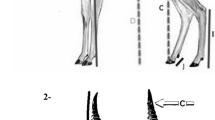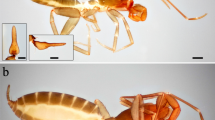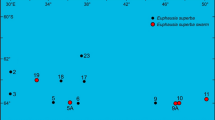Abstract
THE solitary and the swarming phases of the same species of locusts can be distinguished by coloration and by biometrical characters1. Among the latter, the ratio E/F of the elytron length (E) to the posterior femur length (F) has been generally used2, but no proper statistical investigation of the relative merits of various measurements and ratios exists. Careful measurements of all suitable parts of the body have now been undertaken on samples of the desert locust, Schistocerca gregaria (Forsk.), taken from wild populations of a very low density (phase solitaria), and from swarms (phase gregaria), and the data analysed statistically. None of the twenty direct measurements of body parts proved to be suitable, as the frequency distribution polygons for the two phases overlapped widely. The E/F ratios also showed an overlap which made its use uncertain. Moreover, a comparison of E values in the two extreme phases showed that the elytron-length varied, according to the phase, in an opposite direction in the two sexes, thus: 
This is a preview of subscription content, access via your institution
Access options
Subscribe to this journal
Receive 51 print issues and online access
$199.00 per year
only $3.90 per issue
Buy this article
- Purchase on Springer Link
- Instant access to full article PDF
Prices may be subject to local taxes which are calculated during checkout
Similar content being viewed by others
References
Uvarov, “Locusts and Grasshoppers” (London, 1929).
Proc. 4th Inter. Locust Conf. (Cairo, 1937).
Author information
Authors and Affiliations
Rights and permissions
About this article
Cite this article
DIRSH, V. A New Biometrical Phase Character in Locusts. Nature 167, 281–282 (1951). https://doi.org/10.1038/167281b0
Issue Date:
DOI: https://doi.org/10.1038/167281b0
This article is cited by
-
Long-term monitoring of body size and morphometric ratios in the migratory locust, Locusta migratoria (Orthoptera: Acrididae)
Applied Entomology and Zoology (2022)
-
Daily microhabitat shifting of solitarious-phase Desert locust adults: implications for meaningful population monitoring
SpringerPlus (2016)
-
Functional characterization of the corazonin-encoding gene in phase polyphenism of the migratory locust, Locusta migratoria (Orthoptera: Acrididae)
Applied Entomology and Zoology (2016)
-
A Pheromone for Melanization of Locusts
Nature (1963)
-
Some factors influencing phase characters in the nymphs of the locust,Locusta migratoria migratorioides (R. and F.)
Insectes Sociaux (1959)
Comments
By submitting a comment you agree to abide by our Terms and Community Guidelines. If you find something abusive or that does not comply with our terms or guidelines please flag it as inappropriate.



